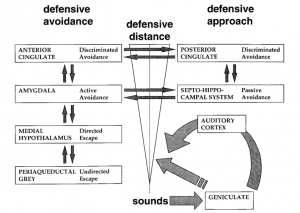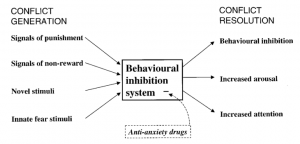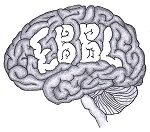
(Gray & McNaughton, 2000)
I originally planned my final post to focus on higher cognitive abilities affected by OCD. This includes influences on attention (Cohen et al., 2003) and decision-making (Da Rocha et al., 2011). However, given feedback I’ve received from earlier posts and a presentation I made in class, I feel compelled to address a different topic. Kate has at least twice asked how is it that an anxiety disorder is related to reward. I agree that this seems counterintuitive. Reward is often associated with positive emotions, and anxiety is clearly a negative emotion. And lack of reward is unlikely to be sufficient to produce the negative emotion of anxiety (though sadness is likely to result from a lack of reward). Lastly, anxiety is often associated with the amygdala or hippocampus (Spampinato et al., 2009; Gray & McNaughton, 2000), but reward is part of the dopaminergic system that includes the striatum, thalamus, and the orbitofrontal cortex. In this post I will try to make the connection between poor reward consumption and anxious behavior exhibited in those with OCD.
I start my argument with a basic correlation argument based on some neurological evidence. Numerous studies have associated OCD with the cortical-thalmal-striatal-cortical pathway (Saxena & Rauch, 2000; Tukel et al., 2014; Harrison et al, 2013). However, the amygdala and hippocampus are rarely mentioned in regards to OCD. These anxiety centers may be active during the anxious behavior but may not be the source of the disorder. Gray & McNaughton (2000) said it better:
“… a prevalence of panic symptoms does not necessarily indicate a disorder of the structures that (proximately) mediate these symptoms, as they may well be a secondary consequence of disorder in some other part of the defence system”
I believe the anxiety to be the effect of this disorder and not the cause. As a result, my focus is one the role of the dopaminergic pathways, especially the rolls of the OFC and striatum in the reward system. It is my hypothesis that the anxious behavior is a result of a malfunction in processing rewards. This malfunction may in turn by the cause of the anxiety.

(Gray & McNaughton, 2000)
One potential cause of anxiety is the “failure or loss of reward” (Gray & McNaughton, 2000). Their model of anxiety focuses on the role of the hippocampus, and they propose it compares anticipated state and current state and that anxiety comes from a mismatch of these (see “conflict generation” in figure). I really like this model for many reasons. First, it is consistent with my hypothesis that part of the problem may lay in the reward system. I also like that it potentially uses a comparison function. The model of memory (and memory-based appraisals) that I use is based on analogical comparisons. In the near future, I hope to model the role of the hippocampus in finding these mismatches using analogical comparisons.
In the meantime, I have more crudely modeled anxiety simply as not fully consuming the anticipated rewards. My simulation (http://www.affectivecognition.com/panksepp/OCD.html) has three agents (a mother and two children) exploring a virtual environment. I’ve marked one of the agents as having OCD by reducing the amount of reward it is able to consume at each food location. Other than this fractional reduction in reward processing, the two child agents are identical. If any agent does not consume as much reward as anticipated at any location, then anxiety begins to mount. If anxiety passes a threshold, the agent returns to the last spot at which rewards were not fully realized and continues to attempt to acquire more reward. Observations of this simulation reveal that any agent may begin to exhibit this behavior of returning to a spot to reinspect it. However, only the “OCD agent” will continuously exhibit this behavior and repeatedly return to the same spot.
I characterize this behavior of returning to a location repeatedly as a checking behavior. This is one example of how the lack of reward may manifest itself as an anxious behavior. I can imagine that other behaviors, such as washing or hoarding, are also linked to a lack of reward and the anxiety that stems from this mismatch.
There is still much not understood about OCD and its causes. I hope over this series of posts I have given the reader a plausible explanation that some OCD behaviors may be linked to a malfunction of the reward system, which in turn causes anxiety, which in turn may trigger behaviors to relieve this anxiety.
References
Cohen, Y., Lachenmeyer, J. R., & Springer, C. (2003). Anxiety and selective attention in obsessive–compulsive disorder. Behaviour Research and Therapy, 41(11), 1311–1323.
Da Rocha, F. F., Alvarenga, N. B., Malloy-Diniz, L., & Corrêa, H. (2011). Decision-making impairment in obsessive-compulsive disorder as measured by the Iowa Gambling Task. Arquivos de Neuro-Psiquiatria, 69(4), 642–7.
Gray, J. A., & McNaughton, N. (2003). The neuropsychology of anxiety: An enquiry into the function of the septo-hippocampal system (No. 33). Oxford University Press.
Harrison, B.J., Pujol, J., Cardoner, N., Deus, J., Alonso, Pl, Lopex-Sola, M., … Soriano-Mas, C. (2013). Brain corticostriatal systems and the major clinical symptom dimensions of obsessive-compulsive disorder. Society of Biological Psychiatry, 73, 321-328.
Saxena, S., & Rauch, S. L. (2000). Functional Neuroimaging and the Neuroanatomy of Obsessive-Compulsive Disorder. Psychiatric Clinics of North America, 23(3), 563–586.
Tukel, R., Aydin, K., Ertekin, E., Ozyildirim, S.S., & Taravari, V. (2014). Proton magnetic resonance spectroscopy in obsessive-compulsvie disorder: Evidence for reduced neuronal integrity in the anterior cingulated. Psychiatry Research: Neuroimaging.
